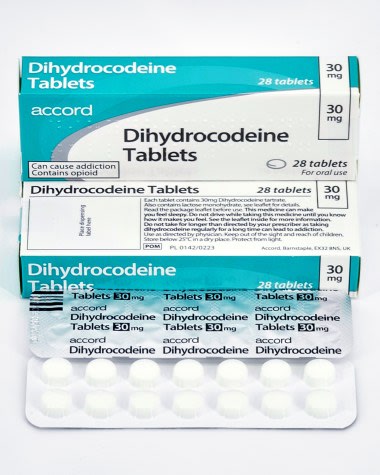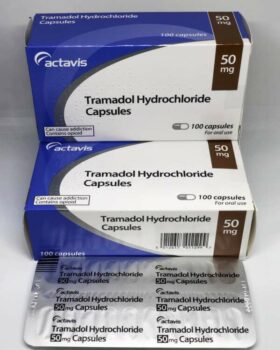- Your cart is empty
- Continue Shopping

Product
Dihydrocodeine 30mg
£92.00Current price is: £92.00. Original price was: £104.00.
Dihydro codeine is used for the treatment of moderate to severe pain, including post-operative and dental pain. It can also be used to treat chronic pain breathlessness and coughing. Dihydrocodeine is an opioid analgesic used as an alternative or adjunct to codeine to treat moderate to severe pain, severe dyspnea, and cough.
Buy dihydro codeine tablets:
Acetaminophen, caffeine, and dihydrocodeine combination is used to relieve moderate to moderately severe pain.
Acetaminophen is used to relieve pain and reduce fever in patients. It does not become habit-forming when taken for a long time. But acetaminophen may cause other unwanted effects when taken in large doses, including liver damage. Caffeine is a CNS stimulant that is used with pain relievers to increase their effectiveness. It has also been used for migraine headaches. Dihydrocodeine belongs to the group of medicines called narcotic analgesics (pain medicines). It acts on the central nervous system (CNS) to relieve pain.
When dihydrocodeine is used for a long time or in large doses, it may become habit-forming, causing mental or physical dependence. However, people who have continuing pain should not let the fear of dependence keep them from using narcotics to relieve their pain. Mental dependence (addiction) is not likely to occur when narcotics are used for this purpose. Physical dependence may lead to withdrawal side effects if treatment is stopped suddenly. However, severe withdrawal side effects can usually be prevented by gradually reducing the dose over a period of time before treatment is stopped completely.
Key facts
- Dihydro codeine works by stopping pain signals traveling along the nerves to the brain.
- Standard dihydrocodeine tablets take 1.5 to 2 hours to work fully.
- It’s possible to become addicted to dihydrocodeine, but this is rare if you’re taking it to relieve pain and you’re taking it as a doctor has prescribed.
- Dihydro codeine can cause withdrawal problems. Do not stop taking the medicine suddenly.
- The most common side effects are feeling or being sick, feeling drowsy, or constipation.
Who can and cannot take it
Adults and children aged 4 years and over can take dihydrocodeine.
Dihydro codeine is not suitable for some people. Tell a doctor before taking the medicine if you:
- have ever had an allergic reaction to dihydrocodeine or any other medicine
- have any stomach problems, such as irritable bowel syndrome (IBS) or Crohn’s disease, or if you’re taking medicines for these conditions
- have lung problems, asthma, or breathing difficulties
- have a head injury or a condition that causes seizures or fits

- have an underactive thyroid gland (hypothyroidism)
- have an addiction to alcohol
- take any other painkillers (including those you buy from a pharmacy or supermarket)
- have liver or kidney problems
- have myasthenia gravis, a rare illness that causes muscle weakness
- are trying to become pregnant, are already pregnant, or are breastfeeding
- are under 18 years and have had your tonsils or adenoids taken out to treat obstructive sleep apnoea
- have a rare condition causing problems with galactose intolerance
Buy Dihydro Codeine (High Strength)
How and when to take it
It’s important to take dihydrocodeine as your doctor has asked you to.
Swallow the tablets whole with water. It’s best to take them with or soon after a meal or snack.
How much will I take?
Dihydrocodeine tablets come in 5 different strengths. The tablets contain 30mg, 40mg, 60mg, 90mg or 120mg of dihydrocodeine.
How often you take your tablets will depend on the strength.
Immediate-release tablets
The usual dose for adults and children aged 12 years and over is:
- 30mg tablet – 1 tablet every 4 to 6 hours – maximum dose in 24 hours is 6 tablets (180mg)
- 40mg tablet – 1 or 2 tablets up to 3 times in 24 hours – maximum dose in 24 hours is 6 tablets (240mg)
Slow-release tablets
The usual dose for adults and children aged 12 years and over is:
- 60mg, 90mg or 120mg tablets – 1 tablet taken every 12 hours

The tablets contain 60mg, 90mg or 120mg of dihydrocodeine. The usual dose is between 60mg and 120mg, taken twice a day.
Liquid
The usual dose of dihydrocodeine liquid is one to three 5ml spoonfuls taken every 4 to 6 hours. One 5ml spoonful has 10mg of dihydrocodeine in it (3 spoonfuls contain 30mg).
For children aged between 4 and 11 years dose is worked out based on weight. The usual dose is between 0.5mg and 1mg per kg of body weight, up to a maximum dose of 30mg every 4 to 6 hours.
If you’re taking dihydrocodeine as a liquid, it will come with a plastic medicine spoon or syringe to help you measure the correct amount. Ask a pharmacist for one if you do not have it.
Do not measure the liquid with a kitchen teaspoon because it will not give the right amount.
Will my dose go up or down?
Usually, you’ll start on a low dose of standard dihydro codeine. Your doctor may increase this gradually until your pain is well controlled.
What if I forget to take it?
This will vary depending on which type of dihydrocodeine you’re taking.
If you forget to take a dose, check the patient information leaflet inside the packet or ask a pharmacist or doctor for advice on what to do.
Never take 2 doses at the same time to make up for a forgotten one.
If you often forget doses, it may help to set an alarm to remind you. You could also ask a pharmacist for advice on other ways to remember to take your medicine.
What if I take too much?
If you go to A&E, do not drive yourself – get someone else to drive you or call for an ambulance.
Take the dihydro codeine box or leaflet inside the packet plus any remaining medicine with you.
Where to store dihydrocodeine
If you’re prescribed dihydrocodeine, it’s really important that you:
- store it properly and safely at home
- keep it out of the sight and reach of children
- do not give your medicine to anyone else
- return any unused dihydro codeine to a pharmacy so they can throw it away in the right way
Additional Information
| Pricing Pack |
|---|
2 reviews for Dihydrocodeine 30mg
Only logged in customers who have purchased this product may leave a review.







Hassan –
First time using this company, had no problems, Very resonable prices and delivery and packing verygood. payment was made quick using bank transfer.
Leanne –
Super service and quick delivery. I did use next day delivery this time as we were in a hurry but last time the product had arrived just next day. Will definitely use again.